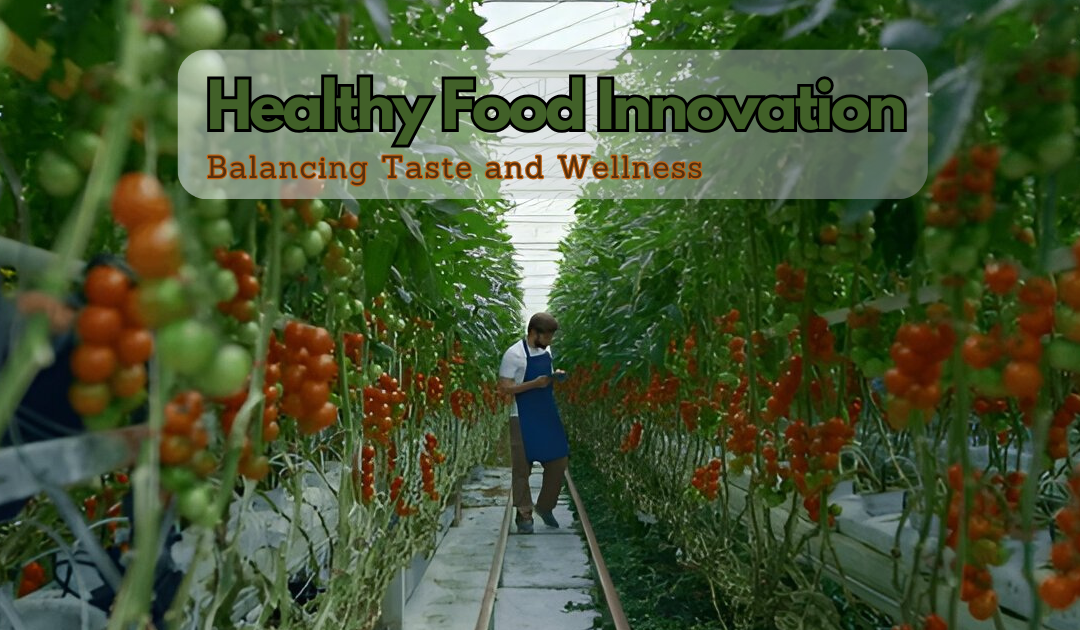In an are where Healthy Food Innovation consciousness is at an all-time high, consumers are increasingly seeking food options that not only satisfy their taste buds but also contribute positively to their overall well-being. This shift has prompted a wave of innovation in the food industry, leading to the development of healthier food products that appeal to the modern consumer’s desire for taste without compromising on nutritional value. As the industry evolves, the challenge lies in striking the right balance between flavor and health, ensuring that innovations are both delicious and beneficial.
The Growing Demand for Healthy Food Options
The demand for healthy food innovation options has surged in recent years, driven by several factors, including rising health concerns, increased awareness of nutrition, and changing lifestyle choices. According to a report by Grand View Research, the global healthy snacks market was valued at $23.92 billion in 2021 and is expected to grow at a compound annual growth rate (CAGR) of 5.9% from 2022 to 2030. This growth signifies a broader trend towards health-oriented eating habits that are reshaping the food landscape.
Consumer Preferences and Trends
A recent survey by Mintel revealed that 74% of consumers are trying to eat healthier, with 58% stating that they read nutrition labels more than ever. Additionally, the International Food Information Council (IFIC) reported that 43% of consumers are influenced by health claims when making food purchases. This data highlights a significant shift in consumer behavior, with health becoming a primary factor in purchasing decisions.
Furthermore, millennials and Gen Z are leading the charge towards healthier food choices. According to Nielsen, 75% of millennials are willing to pay more for food products that offer health benefits. This demographic prioritizes transparency, sustainability, and clean labels, pushing companies to innovate while adhering to these values.
The Challenge of Balancing Taste and Wellness
Despite the growing demand for healthy food innovation options, the food industry faces a significant challenge: how to create products that are both healthy and appealing to the palate. Historically, many health-focused products have been perceived as bland or unappetizing, leading to consumer reluctance. A study published in the journal Appetite found that taste is the primary driver of food choice, with 88% of participants indicating that taste was more important than health benefits.
The Flavor Factor
To overcome this challenge, healthy food innovation manufacturers are increasingly focusing on flavor innovation. This involves utilizing various techniques, ingredients, and cooking methods to enhance the taste of healthy products. For instance, the use of herbs, spices, and natural flavor enhancers can elevate the flavor profile without adding excessive calories or unhealthy ingredients.
Examples of Flavor Innovations:
- Umami Enhancements: Incorporating umami-rich ingredients like mushrooms, miso, or nutritional yeast can create a savory depth of flavor, making healthy foods more enjoyable.
- Functional Ingredients: Adding ingredients like turmeric, ginger, or matcha not only boosts health benefits but also enhances taste. For instance, turmeric can add a warm, earthy flavor while providing anti-inflammatory properties.
- Natural Sweeteners: As consumers seek alternatives to refined sugars, the use of natural sweeteners like stevia, monk fruit, or dates allows for sweetness without the associated health risks.
Innovations in Healthy Food Products
The food industry is brimming with innovative products designed to cater to health-conscious consumers. Here are some notable trends and examples of healthy food innovations that successfully balance taste and wellness:
1. Plant-Based Alternatives
The rise of plant-based diets has led to a surge in plant-based food innovations. According to Nielsen, sales of plant-based foods grew by 27% in 2020, reaching $7 billion in the United States alone. Companies are developing plant-based alternatives to traditional meat and dairy products, ensuring they remain flavorful and satisfying.
Example: Beyond Meat and Impossible Foods have gained immense popularity for their plant-based burgers that mimic the taste and texture of beef. These products are designed not only to be healthier options but also to satisfy the cravings of meat lovers.
2. Functional Foods
Functional foods are products that provide health benefits beyond basic nutrition. These foods often contain added vitamins, minerals, or other bioactive compounds that support specific health outcomes.
Example: Kefir is a fermented milk drink rich in probiotics, which promote gut health. Brands like Lifeway have created flavored kefir options that are both delicious and beneficial, catering to consumers looking for tasty yet functional beverages.
3. Healthy Snacks
The snack industry has seen a significant shift towards healthier options as consumers seek convenience without compromising health. According to a report by Technavio, the global healthy snacks market is projected to grow by $77.81 billion from 2020 to 2024.
Example: Brands like Baked by Melissa offer mini cupcakes made with organic ingredients, allowing consumers to indulge without overindulging. Additionally, companies like RXBAR emphasize clean labels, using simple ingredients while delivering great taste.
4. Nutritious Meal Kits
Meal kits have gained popularity as consumers look for convenient ways to prepare healthy meals at home. These kits often include pre-portioned ingredients and easy-to-follow recipes, promoting healthier cooking habits.
Example: Blue Apron offers meal kits that focus on balanced nutrition, incorporating fresh vegetables, lean proteins, and whole grains. By providing diverse recipes, Blue Apron helps consumers discover new flavors while adhering to healthier eating patterns.
The Role of Technology in Healthy Food Innovation
Advancements in technology are playing a crucial role in the development of healthy food products. From food science innovations to data analytics, technology is driving the food industry towards healthier options.
1. Food Science and Ingredient Innovations
Research in food science has led to the discovery of new ingredients and techniques that enhance flavor while improving nutritional profiles. For example, the development of plant proteins has enabled manufacturers to create healthier meat alternatives without sacrificing taste.
2. Data Analytics and Consumer Insights
Companies are leveraging data analytics to understand consumer preferences and trends. By analyzing purchasing patterns and feedback, food manufacturers can create products that align with consumer demands for taste and health.
3. Sustainability and Health
Sustainability is becoming increasingly intertwined with health, as consumers seek products that are not only good for them but also good for the planet. Brands that emphasize sustainable sourcing and production practices resonate well with health-conscious consumers.
Example: Thrive Market promotes organic and non-GMO products while ensuring ethical sourcing. Their commitment to sustainability aligns with consumers’ desires for healthier options that support both personal well-being and environmental responsibility.
Overcoming Barriers to Healthy Food Innovation
Despite the positive trends and innovations in the healthy food sector, there are challenges that companies must navigate:
1. Perception of Healthier Options
One of the significant barriers to widespread acceptance of healthier food options is consumer perception. Many individuals still associate healthy foods with being tasteless or bland. To overcome this, companies must invest in marketing that emphasizes the flavor and enjoyment of their products.
2. Cost and Accessibility
Healthier food options are often perceived as more expensive, which can deter budget-conscious consumers. Brands need to find ways to produce affordable healthy options without compromising on quality. Collaborations with local farmers and sourcing directly from producers can help reduce costs.
3. Regulatory Challenges
Regulatory requirements can pose challenges to food innovation. Companies must navigate labeling, health claims, and ingredient regulations, which can be complex and time-consuming. However, staying compliant with regulations is essential for building consumer trust and credibility.
Conclusion
The food industry is undergoing a significant transformation as consumers increasingly prioritize health alongside taste. Healthy food innovation is at the forefront of this change, with companies striving to create products that cater to the evolving demands of health-conscious consumers. By focusing on flavor enhancement, leveraging technology, and embracing sustainable practices, brands can successfully balance taste and wellness.
As the market for healthy food options continues to expand, companies that invest in innovative solutions and prioritize consumer preferences will be well-positioned for success. The challenge lies not only in creating nutritious products but also in ensuring that they delight the palate, ultimately shaping a healthier and more enjoyable food landscape for everyone.












